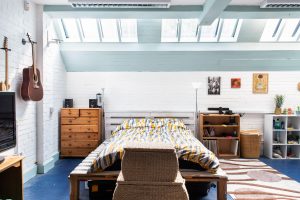
Ovalhouse is a leading example of this. Humbled by the enormous Oval Cricket ground, the theatre has always held its own as a place for artists and audiences of all kinds. There are few institutions whose values truly run through the veins of their operations, but in every story told by Deborah Bestwick – Artistic Director of Ovalhouse for over 20 years – the Ovalhouse spirit of inclusivity and sanctuary shines through. LOWE took over management of the former Ovalhouse theatre in May 2020. The amazing promise of the property was immediately apparent, all that was needed was a group of guardians to care for the property and breathe life back into it.
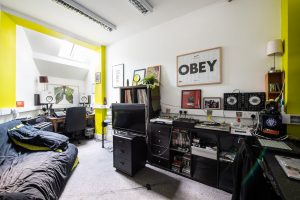
Fortunately, just such a group of guardians were on the lookout for a place where they could work on their music and have the space to collaborate. Living at the property there are singers, an actor and writer with a one-woman show, and a music collective ready to release grassroots works. It’s safe to say these guardians feel right at home in a theatre.
“We were in a guardianship for two years before and we kind of learned how to deal with living in a guardianship. ‘How invested do you get?’ Fully invested is the answer, really.” – Sam
Bearing the largest record collection seen in South London and enough synths to put Kraftwerk to shame, this music collective known as ‘Longreel Records’ has completely committed to filling the Ovalhouse walls with music and art once more. As the final group of artists and creatives make their home at Ovalhouse, it is an appropriate time to reflect on Ovalhouse’s history as a culturally significant establishment and an incredibly valuable humanitarian organisation. As such, we met with Deborah at the property to meet the guardians and tell us about the true history of Ovalhouse.
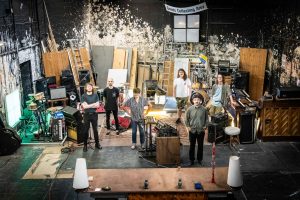
The original Ovalhouse building was founded in the 1930s as a Boys Club that offered opportunities such as debating, boxing, chess, camping and model aeroplane workshops to young people. In 1961, the club took a sharp turn with the appointment of Peter Oliver as the warden. He replaced football with drama, and despite the “Oliver Must Go” graffiti left by disgruntled football fans, this was ultimately an incredibly positive change marking the beginnings of what would become Ovalhouse. What used to be the chapel for the Boys Club eventually became the theatre that premiered Piers Brosnan’s first production, complete with a live donkey who called Ovalhouse home for the three-day run. Ironically, this former chapel became “the crucible of 1960s experimental theatre… every new wave of theatre has started in there. Every time there has been a thing like ‘is this even legal’ it’s been in there.”
Alongside these cutting-edge artists who were pushing the boundaries of theatre and audience sensibilities, the focus on nurturing young people remained. The model of youth participation Peter and his wife Joan implemented at Ovalhouse placed ownership and democracy at the heart of their program. This practice of self-determination continued to be a core value at Ovalhouse and extended to include external groups such as the Black Panthers Youth organisation who would have meetings at the property. Art does more than imitate life, it is a true expression of the time in which it’s made. For Ovalhouse, art and activism belong together. They resourced the first Pride March alongside the formation of Gay Sweatshop, the leading LGBT theatre company of the day. Deborah recounted the impressive Ovalhouse rap sheet:
“The growth of theatre by black artists saw writers, actors and directors like Bernadine Evaristo and Paulette Randall develop their careers, and Graeae Theatre, the country’s first professional disability-led theatre company, now led by Jenny Sealy who co-directed the opening of the 2012 Paralympics, had their first paid performance at the venue. Sanjeev Bhaskar, musician Nitin Sawhney, Pierce Brosnan, Meera Syal, Tim Roth, Artistic Director of the Manchester Royal Exchange Roy Alexander Weise are all amongst the many artists who found an early home at Ovalhouse.”
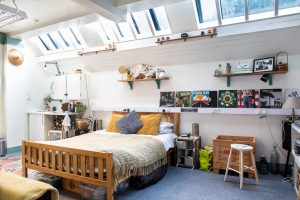
The Ovalhouse model always placed artists first. In creative industries, nothing is more important than a ‘room of one’s own’. Ovalhouse not only offered the space for performance, but also the facilities and space for workshops and rehearsals. Through this holistic, creative approach the building became as much a part of the art as the people. The retro-futuristic turret, aka ‘The Garrett’, was draped in silks as aerial artists brought a new dimension to the space. The doors that open into mid-air, two stories above the car park, became the balcony from which audiences witnessed the murder of Mercutio as he was run over by a twoc’ing Tybalt. One rehearsal studio, now a beautiful guardian bedroom with a New York loft vibe, was filled ankle deep with eucalyptus so when you walked on it the scent billowed up. This was a project done with Mark Storor who held workshops with, and worked on, this project with a group of young refugees. If nothing else, the scorch marks in the lobby from the demolition party indicate a theatre that isn’t afraid of art.
The guardians are not the first artists to make their home here. The label ‘Immersive Theatre’ barely scratches the surface of the dynamic and spatially cognizant work that was crafted and performed at Ovalhouse. For three weeks, a theatre company took up residence in the upstairs theatre, eating only the food the audience provided. That is, until the monotony of crisps and apples – and at one point a whole raw chicken – reached crisis point and they accepted fiscal donations for a take-away. Ovalhouse also ran Time Bomb Theatre where they would bring young people straight from school on a Friday, set a 48-hour clock and work with them night and day to develop their own piece. These pieces were often installations across the building, making the most of the quirky spaces with tailor-made theatre.
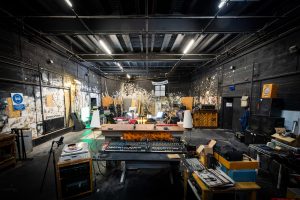
At the heart of Ovalhouse lies the main theatre. The floor is like the rings of a tree, each layer marking a different era, a different manifestation of Ovalhouse. In spots the parquet floor can be seen and wooden floorboards peep through. Today the final layer for the theatre floor is a collection of rugs that would not be amiss in an 80s recording studio. The guardians have set up a keyboard station centred around the original Ovalhouse piano which has the fingerprints of South London Jazz all over it; a stand-out alumnus being South African jazz pianist Bheki Mseleku. The walls are peppered with art from various residencies, hanging signs and the scars from years of experimentation.
The guardians at this property are an appropriate encore for this house of art. As Deborah said, “It’s almost so cheesy that it is now literally a home for artists!” The similarities between the guardian mentality and the theatre mentality are apparent to both guardians and Deborah. These two ways of life require thriftiness, fortitude, a desire to create and a desire to foster community. They make the most of the space they are given and rely on swapping and exchange of labour when they can. The guardians’ rooms speak for themselves. Their clean-cut furnishing, the carefully planned colour schemes, and the pristine array of audio equipment and instruments have transformed the former offices, weightlifting space, recording studio, and rehearsal rooms into a beautiful home. The guardians’ previous guardianship was in a factory outside of London. The change to living in a property built for art has made all the difference for them:
“It has given us a lot of inspiration. Compared to the old guardianship where it felt like we were battling the guardians and the building to be able to be creative, here it has been embraced. You feel that, in the general vibe of things. You wake up and you want to create, it’s very positive.” – Mat
With the construction of Brixton House well underway, this period of reflection is coupled with an excitement for what is to come. The spirit of adventure, experimentation and social consciousness that was born at Ovalhouse will live on in Brixton. As Deborah compiles the rich history of Ovalhouse, the new artistic director Gbolahan Obisesan looks ahead with the Brixton House programming with a focus on social justice and equal opportunity. The guardians at Ovalhouse could not be more pleased with their new home, and this final artistic residency is a fitting dovetail into the new era of Ovalhouse.
If you have a vacant building and you would like to find out how our bespoke service can work for you, contacts us today for a free consultation report with our recommendations on how best to protect your building.